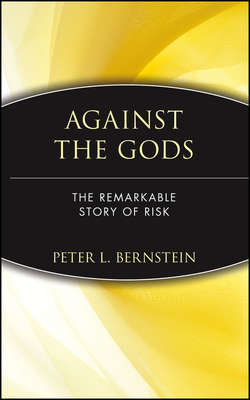Читать книгу Against the Gods - Bernstein Peter L. - Страница 9
1200–1700: A THOUSAND OUTSTANDING FACTS
ОглавлениеChapter 3
The Renaissance Gambler
Piero della Francesca, who painted the picture of the Virgin that appears on the following page (“The Brera Madonna”), lived from about 1420 to 1492, more than two hundred years after Fibonacci. His dates place him at the center of the Italian Renaissance, and his work epitomizes the break between the new spirit of the fifteenth century and the spirit of the Middle Ages.
Delia Francesca’s figures, even that of the Virgin herself, represent human beings. They have no halos, they stand solidly on the ground, they are portraits of individuals, and they occupy their own three-dimensional space. Although they are presumably there to receive the Virgin and the Christ Child, most of them seem to be directing their attention to other matters. The Gothic use of shadows in architectural space to create mystery has disappeared; here the shadows serve to emphasize the weight of the structure and the delineation of space that frames the figures.
The egg seems to be hanging over the Virgin’s head. More careful study of the painting suggests some uncertainty as to exactly where this heavenly symbol of fertility does hang. And why are these earthly, if pious, men and women so unaware of the strange phenomenon that has appeared above them?
Madonna of Duke Federico II di Montefeltro. Pinacoteca di Brera, Milan, Italy.
(Reproduction courtesy of Scala / Art Resource, NY.)
Greek philosophy has been turned upside down. Now the mystery is in the heavens. On earth, men and women are free-standing human beings. These people respect representations of divinity but are by no means subservient to it – a message that appears over and over again in the art of the Renaissance. Donatello’s charming statue of David was among the first male nude sculptures created since the days of classical Greece and Rome; the great poet-hero of the Old Testament stands confidently before us, unashamed of his pre-adolescent body, Goliath’s head at his feet. Brunelleschi’s great dome in Florence and the cathedral, with its clearly defined mass and unadorned interior, proclaims that religion has literally been brought down to earth.
The Renaissance was a time of discovery. Columbus set sail in the year Piero died; not long afterward, Copernicus revolutionized humanity’s view of the heavens themselves. Copernicus’s achievements required a high level of mathematical skill, and during the sixteenth century advances in mathematics were swift and exciting, especially in Italy. Following the introduction of printing from movable type around 1450, many of the classics in mathematics were translated into Italian and published either in Latin or in the vernacular. Mathematicians engaged in spirited public debates over solutions to complex algebraic equations while the crowds cheered on their favorites.
The stimulus for much of this interest dates from 1494, with the publication of a remarkable book written by a Franciscan monk named Luca Paccioli.41 Paccioli was born about 1445, in Piero della Francesca’s hometown of Borgo San Sepulcro. Although Paccioli’s family urged the boy to prepare for a career in business, Piero taught him writing, art, and history and urged him to make use of the famous library at the nearby Court of Urbino. There Paccioli’s studies laid the foundation for his subsequent fame as a mathematician.
At the age of twenty, Paccioli obtained a position in Venice as tutor to the sons of a rich merchant. He attended public lectures in philosophy and theology and studied mathematics with a private tutor. An apt student, he wrote his first published work in mathematics while in Venice. His Uncle Benedetto, a military officer stationed in Venice, taught Paccioli about architecture as well as military affairs.
In 1470, Paccioli moved to Rome to continue his studies and at the age of 27 he became a Franciscan monk. He continued to move about, however. He taught mathematics in Perugia, Rome, Naples, Pisa, and Venice before settling down as professor of mathematics in Milan in 1496. Ten years earlier, he had received the title of magister, equivalent to a doctorate.
Paccioli’s masterwork, Summa de arithmetic, geometria et proportionalità (most serious academic works were still being written in Latin), appeared in 1494. Written in praise of the “very great abstraction and subtlety of mathematics,” the Summa acknowledges Paccioli’s debt to Fibonacci’s Liber Abaci, written nearly three hundred years earlier. The Summa sets out the basic principles of algebra and contains multiplication tables all the way up to 60 × 60 – a useful feature at a time when printing was spreading the use of the new numbering system.
One of the book’s most durable contributions was its presentation of double-entry bookkeeping. This was not Paccioli’s invention, though his treatment of it was the most extensive to date. The notion of double-entry bookkeeping was apparent in Fibonacci’s Liber Abaci and had shown up in a book published about 1305 by the London branch of an Italian firm. Whatever its source, this revolutionary innovation in accounting methods had significant economic consequences, comparable to the discovery of the steam engine three hundred years later.
Конец ознакомительного фрагмента. Купить книгу
41
The background material on Paccioli comes primarily from David, 1962, pp. 36–39, and Kemp, 1981, pp. 146–148.
